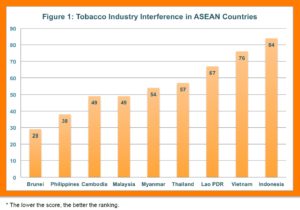Indonesia has once again emerged as a clear laggard in curbing tobacco industry interference in policy-making, according to a report ranking countries in the Southeast Asia region based on their level of implementation of Article 5.3 of the WHO Framework Convention on Tobacco Control (FCTC). It is the third annual report on tobacco industry interference prepared by the Southeast Asia Tobacco Control Alliance (SEATCA).
Indonesia is the only country whose score increased in both the 2015 and 2016 reports among the seven surveyed in all three years (Brunei, Philippines, Cambodia, Malaysia, Thailand, Lao PDR, Vietnam and Indonesia). Its 2014 score of 78 (the first year of the survey) reflected a very high level of interference, and exceeds the scores of all other countries in any year of the survey. Indonesia’s score has continued to worsen, and stands at 84 in the 2016 report. The maximum possible score is 100; a higher score reflects a greater level of interference.

The dismal result is a stark illustration of why Indonesia, one of only a handful of countries that has not signed the FCTC, is a tobacco control ‘rogue state’. The country achieved worldwide infamy in 2010 when a video of a smoking toddler went viral. The video prompted increased media coverage of the striking absence of effective tobacco control policies and regulation in Indonesia, a situation which tobacco companies have taken full advantage of to saturate the country in cigarette advertising.
The Global Adults Tobacco Survey (GATS) of 15 low and middle income countries with high tobacco use published in 2012 found that Indonesia was among the countries with the highest adult male smoking prevalence at 67%. The lax regulations extend to failure to protect Indonesians from secondhand smoke; the GATS also found that 85% of people who visited restaurants were exposed to tobacco smoked and 82% reported seeing cigarette advertising within the last month – exposure far higher than any other country surveyed. Unsurprisingly, Indonesia’s (male) youth smoking prevalence is among the highest in the world; according to the 2014 Global Youth Tobacco Survey, 35% of boys aged 13-15 are current smokers.
At the other end of the scale, the standout countries in the 2016 report were Brunei and the Philippines. Brunei was ranked first for the third year in a row with a score of 29, unchanged from 2014 and 2015. The Philippines has seen a dramatic improvement from a score of 71 in 2014 down to 38 in 2016. Cambodia and Malaysia have also shown consistent improvement from their 2014 scores to be ranked equal fourth at a score of 49 in 2016.
The SEATCA report can be accessed by clicking here.